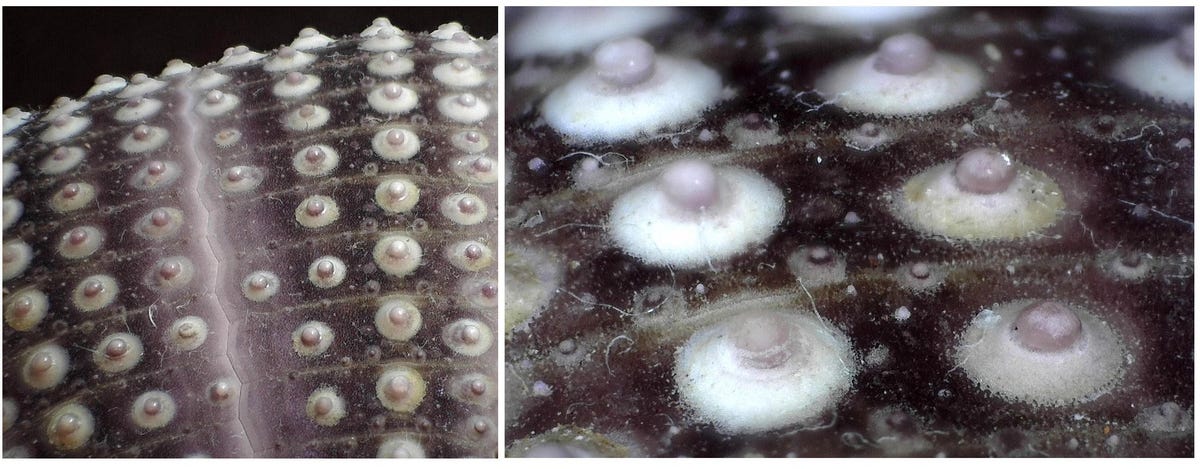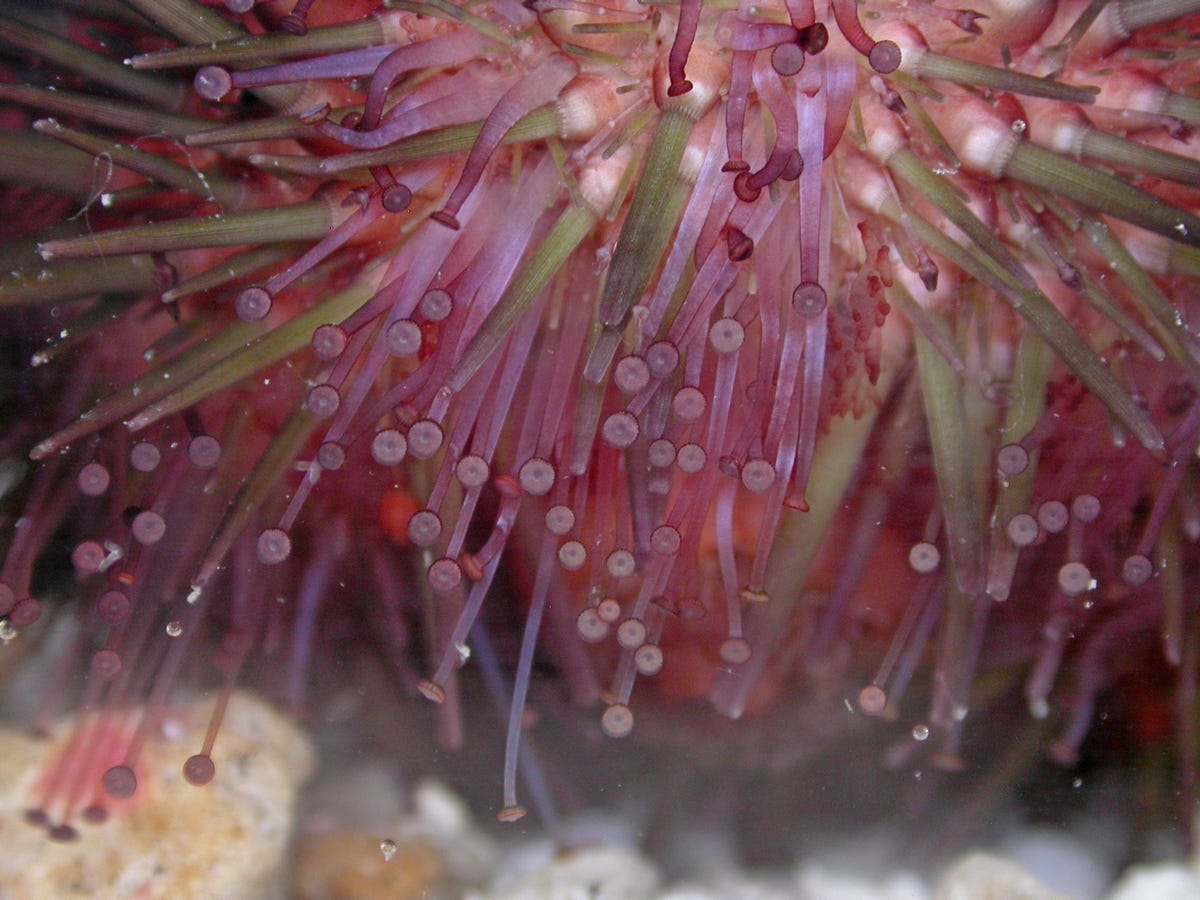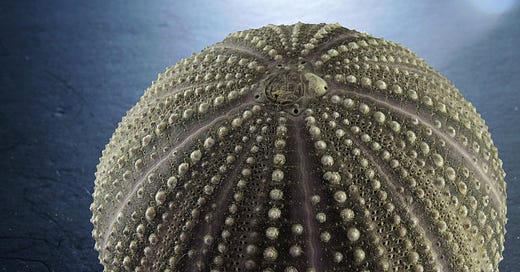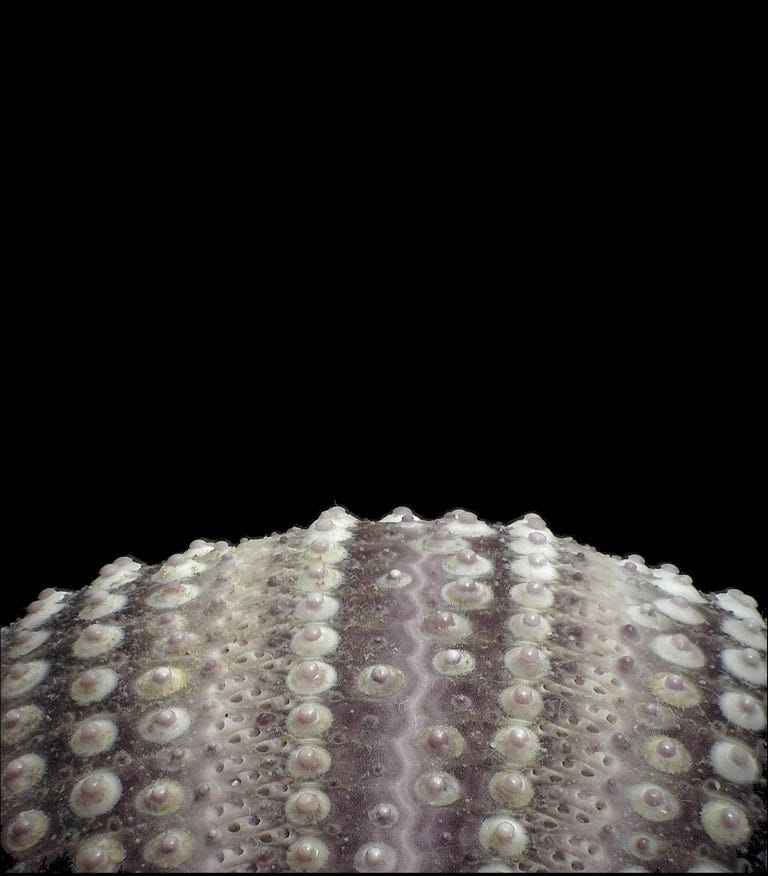For strangeness of animal life, it is hard to beat the echinoderms (sea urchins, starfish, sand dollars, sea cucumbers, brittle stars, and sea feathers). Not one of them conforms to what we typically think of as “animals”. Even their common names suggest that we have trouble considering them animals--- feathers? cucumbers? fish? urchins? dollars? Really, is that the best we can do? But this naming problem reflects my conviction that no one familiar with “regular animals” would have designed these creatures. Echinoderms clearly carry out all the normal functions it takes to stay alive—- eat, grow, reproduce, move, respire and metabolize—- but they carry some of these out in very peculiar ways, ways that differ from “regular” animals. An animal that uses a single system (the water vascular system) to walk, attach, exchange gases, excrete and defend itself stands out among animals as strange.
I will use a Found Object that might as well be called Beach-goer’s Found Object--- a sea urchin test (skeleton)--- to explore the strangeness of these creatures. I expect that hundreds of thousands of these objects have been collected by beachcombers, only to be forgotten in a bag or bucket. In life, the test of the urchin was completely covered with a living tissue both outside and inside, that is, the test is an internal skeleton, a deer skull on the forest floor, or an armadillo on the roadside, ready to tell stories about the animal of which it was once a part.

An intact sea urchin test is a marvel of symmetry and design. Shaped like a water-filled balloon flattened slightly by gravity as it sits on a table, its rows of bumps radiate out from the top--- mountain ranges of different heights circling the urchin, flat valleys separating the ranges. Seen from “urchin space” the test resembles the first views of earth from satellites, or perhaps a Battle Star studded with rows of gun turrets, drifting through intergalactic space….
But of course, it is neither a planet nor a battle star, but the earthly skeletal remains of a sea urchin, a member of the Phylum Echinodermata, the spiny-skinned animals. As we explore Planet Urchin with our Urchin Rover, keep in mind that, much as in the exploration of the remains of Mars, we can only see features that remain after death. To understand these features, though they be interesting in their own right, we must turn to living sea urchins.
Among the more prominent features of Planet Urchin is that, like Mars and other planets, it has a “north pole” and, though not visible in the first image above, a “south pole”, creating lines of longitude and latitude between them. Along lines of longitude, there are rows of large bumps with smaller bumps scattered among them, along with ten rows of paired holes. Rigid calcareous plates (called ossicles), mostly six-sided, fit together like tiles on a bathroom floor to make up Urchin’s surface. This creates a rigid box and makes body wall musculature unnecessary.
As we orbit around Urchin, we see that these longitudinal rows group into five repeating units that run from pole to pole, like the segments of an orange. Thus, as expected of a planet, Urchin has the radial symmetry of a sphere around its central axis, but this symmetry is five-fold (rather than infinite), a trait found in all echinoderms.
With a live sea urchin in hand, our postmortem reveals that the rows of bumps were bases of movable spines attached by means of muscles. These spines are what gives echinoderms their name, but have fallen off in death. In the live sea urchin below, the variation in spine sizes and their attachments shows clearly. In life, the urchin was a living, ambulating pincushion with an oversupply of swiveling pins of different sizes, a walking cactus, truly a “spiny-skinned animal.”


Spines vary enormously among urchin species as well. They can be extremely long and sharp (and poisonous) as in the black urchin, Diadema, thick and appealing as in the pencil urchin spines used in the Must-Buy tourist jewelry in every tropical paradise, or even flower-shaped, flattened, stubby or club-shaped in some of the stranger urchins. There are even spines with tiny jaws at their ends that nip at any creatures settling on the urchin, thereby keeping it clean. In some echinoderm species, these stalked jaws are so developed that they capture fish for the animal’s dining pleasure.

Our Rover found a complex feature at Urchin’s north pole that was very different from the rest of the planet. It consisted of a complex central region of tiny ossicles, bounded by ten larger ossicles, five of them with a hole (remember 5-fold radial symmetry?) with one larger ossicle being porous.

Comparing our postmortem observations with a living urchin, we find that the five prominent holes were the exits through which Urchin’s five gonads shed eggs or sperm into the sea (these are spawning animals, either male or female). If you like your sushi with Uni, you now have a landmark to associate with these gonads. The small opening amidst the central cluster of ossicles is the anus, the terminus of the digestive system (everybody needs one), and the large, porous plate is the madreporite, the only feature that does not fit radial symmetry. The madreporite is the entrance/exit of the water vascular system, perhaps the oddest feature of the echinoderms. The ten rows of holes we detected in our post-mortem observations are part of this water vascular system. That these holes open into Urchin’s interior can be seen by lighting the test from behind. A magnified look shows the holes occur in staggered pairs between rows of spines.

A living sea urchin shows the water vascular system in action, a system that is visible externally as parades of tube feet, as below, and internally through the presence of a complex system of canals and plumbing that provide the water to operate the tube feet.

The way it works is this: through the action of cilia that line the systems ducts, water enters/exits the water vascular system through the madreporite to keep the system inflated, and is moved to a circular canal that opens onto five radial canals (5-part symmetry, again), one for each double row of tube feet. Each tube foot passes through a pair of holes and has a bulb (like a turkey baster) on its inside end. To one side, it is also connected to the radial canal by a short duct with a valve. With the valve closed, a contraction of the turkey baster pushes water into the tube foot, extending it, and when muscles in the tube foot wall contract, they push water back to reinflate the bulb--- a push-push hydraulic system.
The outer end of each tube foot is modified into a little sucker disc, allowing it to attach to surfaces (for example, the glass of the aquarium, below). By extending and retracting this army of tube feet, the urchin moves in a coordinated, albeit slow way. In addition to serving as a peculiar mode of locomotion, the tube feet are used to exchange gases, that is, they act as gills. What parsimony! Breathing with your feet!
At Urchin’s south pole, Rover found that a large chunk of surface was missing, including the south pole itself. As in the north pole, the lines of longitude converge on what was the south pole in life. A living urchin reveals that the empty area was made up of many small ossicles bearing a mouth with a complex set of five-part jaws at its center. With these complex jaws (called Archimedes lantern), the urchin cruised around on its tube foot army, nibbling algae off surfaces.

Much of what is strange about echinoderms is not visible in their skeletons. Although echinoderms are radially symmetrical (well, almost, note the madreporite), they evolved from an ancestor that was bilaterally symmetrical like most of the animals in our lives. This ancestry is still apparent in that radially symmetrical adult echinoderms develop from bilaterally symmetrical larvae (a few echinoderms then evolve back to secondary bilaterally symmetry—- apparently, they have trouble making up their minds).
When contemplating how an animal might solve the problems of moving, feeding, excreting, attaching, and exchanging gases, it seems so counter-intuitive (at least to me) to come up with a water vascular system, and the way the system arises during development only strengthens that impression. Like other bilateral animals, the body cavity of the echinoderm larva has as a right and left side, just like you and me, but unlike other animals, these sides have different fates in the adult--- the right side forms the “ordinary” organ-containing (visceral) body cavity while the left side forms, you guessed it! the water vascular system. This system is not only radically different from an “ordinary” body cavity, it consists of an intricate system of canals, valves, and muscular extensions that is open to the sea through the madreporite. From the ordinary to the extraordinary….
All the soft tissues of the urchin were long gone when I found the test on the beach, but the signs registered in its test could be read and understood in an exercise of observation, knowledge, and imagination, ready to give pleasure to our curious inner detective. In a future essay, I will explore the sand dollar, an even stranger echinoderm whose skeleton tends to end up as gold-painted Christmas tree ornaments. I will show how even this echinoderm evolved from a common echinoderm ancestor through extreme modification of a general body plan, another exercise in imagination and observation.




Fantastic mysterious creature. Don't know whether I will ever get to see one of these, living in the hinterlands as I do, but I am fascinated by the wealth of info you have shared, Walter.
Wow!! Astronomy x Ocean. Loved it!